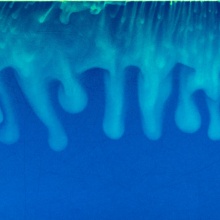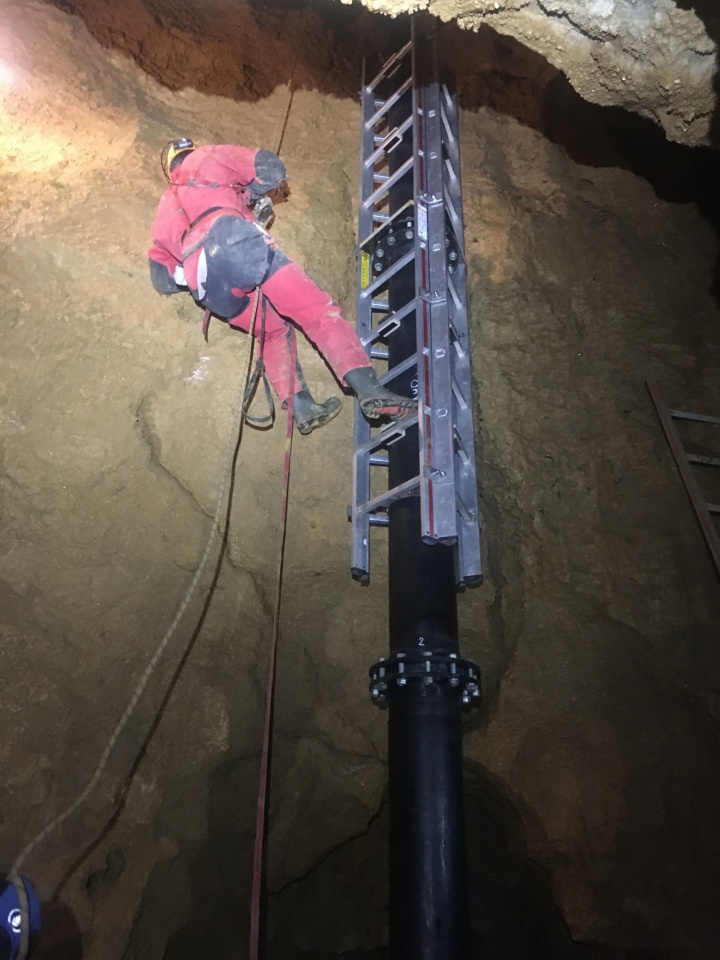The formation of karst caves has already been the subject of much research. However, a team led by Prof. Holger Class, a senior researcher within the Collaborative Research Center (SFB) 1313 at the University of Stuttgart, and supported by the German Research Center for Geoscience (GFZ) Potsdam and the Höhlen- und Heimatverein Laichingen, is pursuing a new theory that could prove to be an important addition to previous theories. In a recent article published in the journal Water Resources Research, the team was able to substantiate the theory using experiments and numerical simulations.
The Swabian Alb has 12 show caves with impressive dripstone formations and rich karst springs that flow at the foot of the Alb mountain range. The caves are formed when microorganisms respire organic material to form carbon dioxide (CO2), which then forms a weak carbonic acid when combined with water from precipitation. If this solution comes into contact with limestone, the limestone dissolves within hours. In summer the microorganisms produce more CO2, in winter less. This results in fluctuations in CO2 content in the soil/cave air and at the boundary surface to the karst water.
The hypothesis
However, the Laichingen-based caver and geologist Harald Scherzer has long suspected that there must be another process driving the underground lime dissolution. His hypothesis: that soil air, carried into the depths by the cave wind, enriches the groundwater with additional CO2, resulting in a "growth spurt" deep under the ground. This approach, which could prove to be an important addition to theories about cave formation, was taken up by Holger Class and his research group from the Institute for Modelling Hydraulic and Environmental Systems (IWS) at the University of Stuttgart. As a senior researcher for the Collaborative Research Center (CRC) 1313, Class worked together with Master's student Pascal Bürkle, to address the fact that density-driven CO2 released in karst, which does not rely on flowing water, has not previously been addressed in the literature, thus shedding new light on the physical processes using experiments and numerical simulations. In particular, they studied CO2 dynamics in water and the conditions under which they occur. In addition, the group determined the level of input rates when CO2 is converted at the karst water surface and the relevance of this process to karst hydrology, geomorphology, or speleology. For the first time, the work has now been subjected to a rigorous scientific peer-review process and was published in the renowned journal Water Resources Research. Bürkle's master's thesis was a central part of the publication.
The experiment – Making the invisible visible
Based on an experimental set-up that was designed for the “Laichinger Tiefenhöhle" cave network, the researchers built a version of this beforehand in the test hall at the University of Stuttgart's Institute for Water and Environmental Systems Modelling (IWS) and it was installed at the caves in April 2021. It comprises a water-filled column, open at the top, which serves as a model for a fictitious underground cave lake. At atmospheric pressure, CO2, the concentration of which has been adjusted to meet cave-equivalent concentrations, is dissolved in the water contained in the column. The water thus becomes heavier and spreads downwards in a so-called “fingering” motion. The experiment made it possible to measure the CO2 concentration in the water at different depths over time and then to compare the concentration increase in the water with simulation results.
“With the help of this experiment, we want to recreate a process that we think is important for cave formation and hopefully show that the transport path of CO2 via the soil air or cave air can also make a significant contribution”, say Prof. Holger Class and Pascal Bürkle. In addition, the researchers also calculated the extent to which the flow of groundwater influences the dissolved CO2 concentration and the input rates at the water surface.
Interdisciplinary collaboration
In this context, the connection to research work by Prof. Ingrid Kögel-Knabner (TU Munich), which focuses on the binding and release of CO2 in the soil, is particularly interesting. Other interesting questions also arise here regarding climate change, because the activity of microorganisms is strongly dependent on temperature and soil moisture, which then potentially plays a role in both the storage of CO2 in the soil and for karstification. And finally, the results of Class’s research also benefit the Collaborative Research Center (SFB) 1313 "Interface-Driven Multi-Field Processes in Porous Media. Flow, Transport and Deformation" at the University of Stuttgart, where precipitation and the dissolution of salt/lime in porous media is one of the "Vision Topics".
Expert Contact:
Prof. Dr. Holger Class, University of Stuttgart, Institute for Modelling Hydraulic and Environmental Systems (IWS), Tel. +49 711 685 64678, E-Mail
„On the role of density-driven dissolution of CO2 in phreatic karst systems”, Holger Class, Pascal Bürkle et al. Water Resources Research, December 2021, https://doi.org/10.1029/2021WR030912



